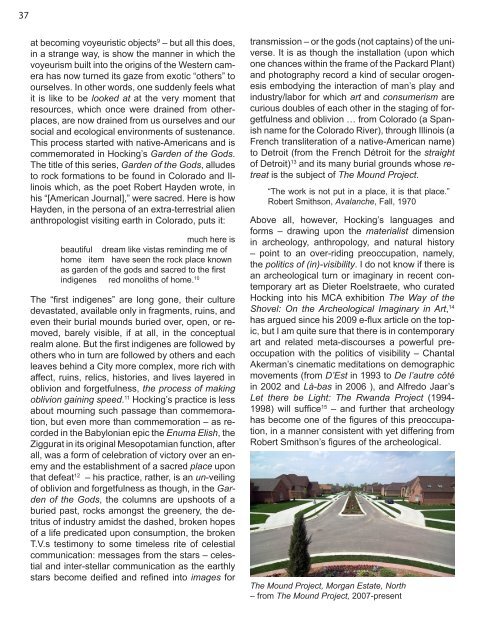Detroit Research Volume 1
You also want an ePaper? Increase the reach of your titles
YUMPU automatically turns print PDFs into web optimized ePapers that Google loves.
37<br />
at becoming voyeuristic objects 9 – but all this does,<br />
in a strange way, is show the manner in which the<br />
voyeurism built into the origins of the Western camera<br />
has now turned its gaze from exotic “others” to<br />
ourselves. In other words, one suddenly feels what<br />
it is like to be looked at at the very moment that<br />
resources, which once were drained from otherplaces,<br />
are now drained from us ourselves and our<br />
social and ecological environments of sustenance.<br />
This process started with native-Americans and is<br />
commemorated in Hocking’s Garden of the Gods.<br />
The title of this series, Garden of the Gods, alludes<br />
to rock formations to be found in Colorado and Illinois<br />
which, as the poet Robert Hayden wrote, in<br />
his “[American Journal],” were sacred. Here is how<br />
Hayden, in the persona of an extra-terrestrial alien<br />
anthropologist visiting earth in Colorado, puts it:<br />
much here is<br />
beautiful dream like vistas reminding me of<br />
home item have seen the rock place known<br />
as garden of the gods and sacred to the first<br />
indigenes red monoliths of home. 10<br />
The “first indigenes” are long gone, their culture<br />
devastated, available only in fragments, ruins, and<br />
even their burial mounds buried over, open, or removed,<br />
barely visible, if at all, in the conceptual<br />
realm alone. But the first indigenes are followed by<br />
others who in turn are followed by others and each<br />
leaves behind a City more complex, more rich with<br />
affect, ruins, relics, histories, and lives layered in<br />
oblivion and forgetfulness, the process of making<br />
oblivion gaining speed. 11 Hocking’s practice is less<br />
about mourning such passage than commemoration,<br />
but even more than commemoration – as recorded<br />
in the Babylonian epic the Enuma Elish, the<br />
Ziggurat in its original Mesopotamian function, after<br />
all, was a form of celebration of victory over an enemy<br />
and the establishment of a sacred place upon<br />
that defeat 12 – his practice, rather, is an un-veiling<br />
of oblivion and forgetfulness as though, in the Garden<br />
of the Gods, the columns are upshoots of a<br />
buried past, rocks amongst the greenery, the detritus<br />
of industry amidst the dashed, broken hopes<br />
of a life predicated upon consumption, the broken<br />
T.V.s testimony to some timeless rite of celestial<br />
communication: messages from the stars – celestial<br />
and inter-stellar communication as the earthly<br />
stars become deified and refined into images for<br />
transmission – or the gods (not captains) of the universe.<br />
It is as though the installation (upon which<br />
one chances within the frame of the Packard Plant)<br />
and photography record a kind of secular orogenesis<br />
embodying the interaction of man’s play and<br />
industry/labor for which art and consumerism are<br />
curious doubles of each other in the staging of forgetfulness<br />
and oblivion … from Colorado (a Spanish<br />
name for the Colorado River), through Illinois (a<br />
French transliteration of a native-American name)<br />
to <strong>Detroit</strong> (from the French Détroit for the straight<br />
of <strong>Detroit</strong>) 13 and its many burial grounds whose retreat<br />
is the subject of The Mound Project.<br />
“The work is not put in a place, it is that place.”<br />
Robert Smithson, Avalanche, Fall, 1970<br />
Above all, however, Hocking’s languages and<br />
forms – drawing upon the materialist dimension<br />
in archeology, anthropology, and natural history<br />
– point to an over-riding preoccupation, namely,<br />
the politics of (in)-visibility. I do not know if there is<br />
an archeological turn or imaginary in recent contemporary<br />
art as Dieter Roelstraete, who curated<br />
Hocking into his MCA exhibition The Way of the<br />
Shovel: On the Archeological Imaginary in Art, 14<br />
has argued since his 2009 e-flux article on the topic,<br />
but I am quite sure that there is in contemporary<br />
art and related meta-discourses a powerful preoccupation<br />
with the politics of visibility – Chantal<br />
Akerman’s cinematic meditations on demographic<br />
movements (from D’Est in 1993 to De l’autre côté<br />
in 2002 and Là-bas in 2006 ), and Alfredo Jaar’s<br />
Let there be Light: The Rwanda Project (1994-<br />
1998) will suffice 15 – and further that archeology<br />
has become one of the figures of this preoccupation,<br />
in a manner consistent with yet differing from<br />
Robert Smithson’s figures of the archeological.<br />
The Mound Project, Morgan Estate, North<br />
– from The Mound Project, 2007-present





